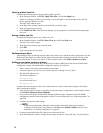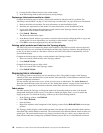
85
Using the Zoning Config window
Use the Zoning Config window to change the Auto Save and Default Visibility configuration parameters.
Complete the following steps to open the Zoning Config window and change configuration parameters:
1. In the Faceplate window, click Zoning / Edit Zoning Config.The Zoning Config window opens.
Figure 10. Zoning Config window
2. Make the necessary changes to the Auto Save and Default Visibility fields and click OK.
Restoring default zoning
Restoring the default zoning clears the switch module of all zoning definitions. Complete the following steps
to restore the default zoning for a switch module.
Attention: The use of this command will deactivate any active zone set. If the switch module is not isolated
from the fabric, this command will deactivate the active zone set for the entire fabric.
1. In the Faceplate window, click
Zoning / Restore Default Zoning.
2. Click
OK to confirm that you want to restore default zoning and save changes to the zoning database.
Merging fabrics and zoning
If you join two fabrics, the active zone sets from the two fabrics attempt to merge. The fabrics can consist of a
single switch module or many switches already connected together. The switch modules in the two fabrics
attempt to create a new active zone set containing the union of the active zone set of each fabric. The
propagation of zoning information affects only the active zone set, not the configured zone sets.
Zone merge failure
If a zone merge is unsuccessful, the interswitch links between the fabrics will isolate because of a zone merge
failure, which generates an alarm log entry. The reason for the E_Port isolation can also be determined by
viewing the port.
information. See the “Port Information Data window” on page 96 and the “Show command” on page 38 (Port
keyword).
A zone merge will fail if the two active zone sets have member zones with identical names that differ in
content or type. For example, consider Fabric A and Fabric B, each with a zone in its active zone set named
“ZS1.” Fabric A “ZS1” contains a member specified by Domain ID 1 and Port 1; Fabric B “ZS1” contains a
member specified by Domain ID 1 and Port 2. In this case, the merge fails, and the interswitch links between
the fabrics are isolated.


















